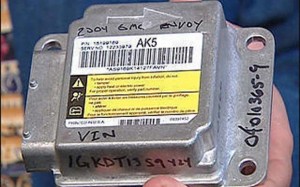The White House has given its okay to a plan that would require all future cars and trucks be equipped with event data records – most commonly referred to as “black boxes.”
The majority of vehicles produced today already have such devices onboard and they have aided in recent investigations into such safety issues as the so-called unintended acceleration scare at Toyota. But the use of the technology has also raised some concerns with privacy advocates.
Congress failed to pass legislation that would have required the use of event data recorders, or EDRs, in 2010. That prompted the National Highway Traffic Safety Administration to consider its own mandate. A review was completed this week by the White House Office of Management and Budget and final regulations will likely follow early next year.
The proposal was originally expected by late 2011 but the process was delayed without explanation. Nonetheless, NHTSA has listed the use of black boxes as a “priority,” a spokesperson insisting such devices are critical to “continued improvements in vehicle safety.”
Automotive EDRs are similar, though not nearly as sophisticated, as the black boxes used in commercial airliners – and which are routinely used to provide critical information about crashes and other aircraft incidents. They are already installed in nearly 92% of today’s vehicles, according to industry officials, and also provide important information for industry engineers and, under some circumstances, law enforcement authorities.
During several investigations looking into claims that Toyota products would unexpectedly begin to accelerate without driver input, researchers used such recorders to see what actually happened, often discovering the issue was, in fact, the result of driver error, such as the application of the throttle rather than the brake.
The industry trade group, the Alliance of Automobile Manufacturers, or AIM, has endorsed the use of black boxes – but has also warned that any new rules must consider privacy issues.
“We need to make sure we preserve privacy,” spokesperson Gloria Bergquist told the Detroit News. “Automakers do not access EDR data without consumer permission, and any government requirements to install EDRs on all vehicles must include steps to protect consumer privacy.”
One concern is that new mandates for such devices might make it easy for authorities to see if a motorist were speeding or otherwise violating the law.
Rules vary by state but in much of the country a law enforcement official – or a plaintiff in a legal case – must get court approval before a vehicle’s black box can today be accessed without the permission of the owner.
As with an airliner’s black box, the current technology records and stores only a limited amount of data – though that is considered enough to piece together a snapshot of what might have led up to a crash, such as whether the driver was applying the brakes or throttle, and if seatbelts were being used. Unlike the aerospace industry, the new regulations are not expected to require taping of conversations in a vehicle’s passenger compartment.
NHTSA already has stepped into the issue requiring that as of the start of the 2013 model-year all EDR data be commonized while simplifying access. The use of proprietary formats complicated the Toyota unintended acceleration investigations.

